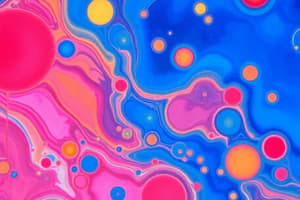Podcast
Questions and Answers
What is one of the main functions of the mixture in emulsions?
What is one of the main functions of the mixture in emulsions?
- It provides the proper hydrophilic-lipophilic nature. (correct)
- It enhances the flavor of the oil phase.
- It increases the volatility of the product.
- It reduces the shelf life of the emulsion.
Which method involves mixing the emulsifying agent with oil before adding water?
Which method involves mixing the emulsifying agent with oil before adding water?
- Bottle method
- In Situ soap method
- Continental or Dry Gum method (correct)
- Wet gum method
What are Tragacanth and agar frequently used for in emulsions?
What are Tragacanth and agar frequently used for in emulsions?
- To decrease the overall viscosity of the product
- To enhance color stability
- To increase the flavor of the oil phase
- To thicken the external phase and reduce creaming (correct)
What is the correct ratio of oil, water, and emulsifiers in the continental method?
What is the correct ratio of oil, water, and emulsifiers in the continental method?
What are the two main steps in the preparation of an emulsion?
What are the two main steps in the preparation of an emulsion?
What is the role of the emulsifying agent in an emulsion?
What is the role of the emulsifying agent in an emulsion?
Which of the following correctly describes an O/W emulsion?
Which of the following correctly describes an O/W emulsion?
What is one advantage of using emulsions over solid dosage forms?
What is one advantage of using emulsions over solid dosage forms?
What are W/O emulsions primarily used for?
What are W/O emulsions primarily used for?
Which of the following statements about emulsions is true?
Which of the following statements about emulsions is true?
Which phase in an emulsion is known as the dispersed phase?
Which phase in an emulsion is known as the dispersed phase?
How do emulsifying agents reduce interfacial tension?
How do emulsifying agents reduce interfacial tension?
What is a common purpose of oral O/W emulsions?
What is a common purpose of oral O/W emulsions?
What is the primary benefit of reducing the particle size of oil globules in emulsions?
What is the primary benefit of reducing the particle size of oil globules in emulsions?
Which type of emulsions are meant for administration via I.V. injection or orally?
Which type of emulsions are meant for administration via I.V. injection or orally?
What characteristic is NOT ideal for emulsifying agents?
What characteristic is NOT ideal for emulsifying agents?
Which of the following is a carbohydrate material that serves as an emulsifying agent?
Which of the following is a carbohydrate material that serves as an emulsifying agent?
What is a disadvantage of using gelatin as an emulsifier?
What is a disadvantage of using gelatin as an emulsifier?
Which type of surfactants are effective at a pH greater than 8?
Which type of surfactants are effective at a pH greater than 8?
Which of the following substances is primarily used as thickening agents for external o/w emulsions?
Which of the following substances is primarily used as thickening agents for external o/w emulsions?
What is the advantage of using a mix of emulsifying agents?
What is the advantage of using a mix of emulsifying agents?
Flashcards are hidden until you start studying
Study Notes
Emulsions
- Biphasic heterogeneous systems containing two immiscible liquids
- One phase (dispersed) is finely subdivided and distributed as droplets within the other (dispersion medium)
- Dispersed phase: internal or discontinuous
- Dispersion medium: external or continuous
- Emulsifying agents stabilize emulsions by:
- Preventing particle coalescence
- Maintaining individual droplet integrity
- Decreasing interfacial tension between liquids
Types of Emulsions
- Oil in water (O/W): Oil is the dispersed phase, water is the dispersion medium
- Water in oil (W/O): Water is the dispersed phase, oil is the dispersion medium
Purposes & Advantages of Emulsions
- Stable and homogeneous mixtures: of immiscible liquids
- Aqueous phase is easily flavored
- Oil taste can be masked
- Faster absorption compared to solid dosage forms
- Oral O/W emulsions:
- Mask oil taste (liquid paraffin)
- Improve oil absorption
- Semisolid emulsions:
- O/W (vanishing creams)
- W/O (cold creams)
- O/W preferred for ease of application and removal
- Smaller particle size: makes oils more digestible and absorbable (e.g., mineral oil as cathartic)
Uses of Emulsions
- Internal Use (oral or IV injection)
- External Use (skin or mucous membrane)
Ideal Emulsifying Agent Characteristics
- Compatible with other ingredients
- Stable and non-deteriorating
- Nontoxic with respect to intended use and dosage
- Minimal odor, taste, and color
- Promotes emulsification and maintains emulsion stability
Types of Emulsifying Agents
- Carbohydrate materials: acacia, tragacanth, agar, pectin (hydrophilic colloids, O/W emulsions).
- Protein substances: gelatin, egg yolk (O/W emulsions).
- High molecular weight alcohols: stearyl alcohol, cetyl alcohol, glyceryl monostearate (thickening agents and stabilizers for O/W emulsions).
- Wetting agents:
- Anionic, cationic, or non-ionic
- Non-ionic: effective pH 3-10
- Cationic: effective pH 3-7
- Anionic: require pH greater than 8
- Finely divided solids: bentonite, magnesium hydroxide, aluminum hydroxide (O/W or W/O depending on mixing order)
Mixed Emulsifiers
- Blends of emulsifiers are more efficient for stable emulsions.
- Benefits:
- Provide proper hydrophilic-lipophilic balance
- Establish stable interfacial film
- Desired consistency to product
- Tragacanth or agar are frequently combined with acacia in O/W emulsions to increase viscosity and slow creaming.
Emulsion Preparation Methods
- Dry Gum Method
- Emulsifying agent (e.g., acacia) mixed with oil before adding water
- Also known as the 4:2:1 method (oil:water:emulsifier)
- Wet Gum Method
- Emulsifier dispersed in water before adding oil
- Bottle Method
- Emulsion formed by shaking ingredients in a closed bottle
- In Situ (Nascent) Soap Method
- Soap formed in situ as the emulsifier
Steps in Emulsion Preparation
- Primary emulsion: thick, creamy, and stable emulsion (oil, acacia, water)
- Dilution: addition of other substances
Methods of Emulsification
- Continental or Dry Gum Method (4:2:1):
- External phase (water) added to internal phase (oil mixed with emulsifier)
Studying That Suits You
Use AI to generate personalized quizzes and flashcards to suit your learning preferences.




